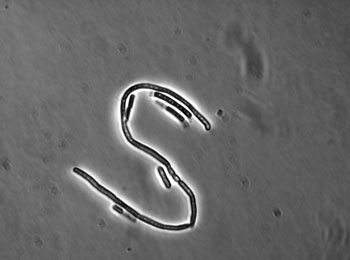A Bacterial Lifestyle Switch Provides Antibiotic Resistance
By LabMedica International staff writers
Posted on 06 Jan 2016
Researchers have reported for the first time that following contact with certain antibiotics the pathogenic Bacillus cereus can switch into a special slowed-down mode and form small colony variants (SVCs) that are difficult to diagnose and almost impossible to treat with certain antibiotics.Posted on 06 Jan 2016
Bacillus cereus causes vomiting and diarrhea as well as systemic and local infections such as sepsis or eye infections. The newly discovered mechanism, from a study led by researchers from the Vetmeduni Vienna (University of Veterinary Medicine Vienna (Austria), provides an explanation for this and possibly other cases of antibiotic resistance.

Image: Light micrograph of Bacillus cereus in a small colony variant (SCV) (Photo courtesy of Markus Kranzler/Vetmeduni Vienna).
B. cereus had so far been considered to be exclusively endospore-forming in response to harsh conditions. The new study discovered an alternative lifestyle in which B. cereus forms SCVs in response to exposure to aminoglycoside antibiotics. The B. cereus SCVs grow slower, have an altered metabolism, and provide resistance to aminoglycosides. “The bacterium protects itself against the harmful effects of the antibiotics by forming these SCVs. But B. cereus is usually treated with exactly those antibiotics which induce the SCV state. If an antibiotic triggers the formation of SCVs, it also triggers resistance,” explained first author Dr. Frenzel.
The discovery of this mechanism is of great significance for clinical practice and will require rethinking diagnostics and therapy. Traditional diagnostics are based on identification of metabolic features of B. cereus, but these tests do not detect SCVs. This may result in incorrect antibiotic therapies or even failed diagnoses. Molecular tests may be the only way to diagnose this form of B. cereus. Treating B. cereus infections using only aminoglycoside antibiotics could bear the risk of a prolonged infection. SCVs grow more slowly, but they still produce toxins that are harmful to the body. “In this case, a combination therapy with other antibiotic groups is advisable,” Dr. Frenzel recommends.
Another bacterium, Staphylococcus aureus, also forms SCVs, but is capable of reverting to its original state. For B. cereus, the SCV form appears to be final, suggesting a new mechanism. “We believe that the SCV formation in B. cereus functions differently than in S. aureus,” said coauthor Dr. Ehling-Schulz.
“The ability to form SCVs appears to be of environmental significance for the bacteria,” said Dr. Frenzel, “B. cereus are soil-dwelling, and other microorganism in the soil produce antibiotics. Here, too, the formation of SCVs would be an advantage for the bacteria.”
The study, by Frenzel E, Kranzler M et al., was published December 8, 2015, in the journal mBio.
Related Links:
University of Veterinary Medicine Vienna




 assay.jpg)








